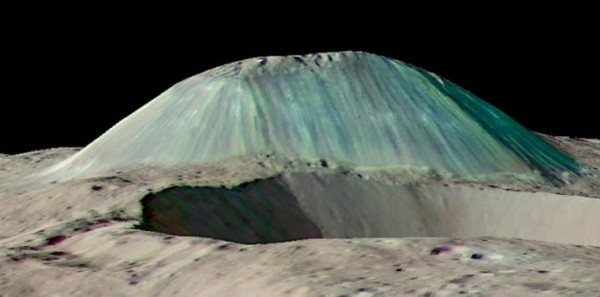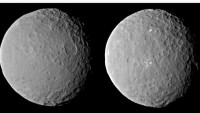Ice Volcano on Dwarf Planet Ceres Erupts Molten Ice
| Arthur Dominic Villasanta | | Sep 02, 2016 06:26 PM EDT |
(Photo : Dawn Science Team and NASA/JPL-Caltech/GSFC) Volcanic dome Ahuna Mons rises above a foreground impact crater, as seen by NASA's Dawn spacecraft
The lone mountain on Ceres, the only asteroid classified as a dwarf planet, is a volcano that hurls out molten ice (not molten lava as on Earth) when it erupts.
This "cryovolcano" named Ahuna Mons rises 13,000 feet high and is 11 miles wide at its base. Ahuna Mons is the largest mountain on Ceres and was formed as a result of cryovolcanic activity from Ceres's interior.
Like Us on Facebook
"Ahuna is the one true 'mountain' on Ceres," said David Williams, associate research professor in Arizona State University's School of Earth and Space Exploration. "After studying it closely, we interpret it as a dome raised by cryovolcanism."
This is a form of low-temperature volcanic activity, where molten ice -- water, usually mixed with salts or ammonia -- replaces the molten silicate rock erupted by terrestrial volcanoes. Ahuna is a volcanic dome built from repeated eruptions of freezing salty water.
Williams is part of a team of scientists working with NASA's Dawn mission that have published papers in the journal Science.
"Ahuna is truly unique, being the only mountain of its kind on Ceres," said Willians whose specialty is volcanism. "It shows nothing to indicate a tectonic formation, so that led us to consider cryovolcanism as a method for its origin."
Dawn scientist Ottaviano Ruesch of NASA's Goddard Space Flight Center in Maryland, is the lead author on the Science paper about Ceres' volcanism.
"This is the only known example of a cryovolcano that potentially formed from a salty mud mix, and which formed in the geologically recent past," according to Ruesch.
Williams noted "Ahuna has only a few craters on its surface, which points to an age of just couple hundred million years at most."
The Dawn team said the implications of Ahuna Mons being volcanic in origin are enormous.
It confirms that although Ceres' surface temperature averages almost -40° (Celsius or Fahrenheit; the scales converge at this temperature), its interior has kept warm enough for liquid water or brines to exist for a relatively long period. And this has allowed volcanic activity at the surface in recent geological time.
Ahuna Mons is not the only place where icy volcanism happens on Ceres. Dawn's instruments have spotted features that point to cryovolcanic activity that resurfaces areas rather than building tall structures.
Many craters show floors that appear flatter than impacts by meteorites would leave them, so perhaps they have been flooded from below. In addition, such flat-floored craters often show cracks suggesting that icy "magma" has pushed them upward, then subsided.
A few places on Ceres exhibit a geo-museum of features.
"Occator Crater has several bright spots on its floor," said Williams. "The central spot contains what looks like a cryovolcanic dome, rich in sodium carbonates." Other bright spots, he says, occur over fractures that suggest venting of water vapor mixed with bright salts.
"As the vapor has boiled away," he explained, "it leaves the bright 1salts and carbonate minerals behind."
Dawn's observations suggest Ceres has an outer shell that's not purely ice or rock, but rather a mixture of both.
Ceres is the second port of call for the Dawn mission, which was launched in 2007 and visited another asteroid, Vesta, from 2011 to 2012.
The spacecraft arrived at Ceres in March 2015. It carries a suite of cameras, spectrometersand gamma-ray and neutron detectors. These were built to image, map, and measure the shape and surface materials of Ceres, and they collect information to help scientists understand the history of these small worlds and what they can tell us of the solar system's birth.
NASA plans for Dawn to continue orbiting Ceres and collecting data for another year or so.
TagsCeres, Ahuna Mons, cryovolcanism, molten ice, Dawn Spacecraft, NASA, David Williams
©2015 Chinatopix All rights reserved. Do not reproduce without permission
EDITOR'S PICKS
-

Did the Trump administration just announce plans for a trade war with ‘hostile’ China and Russia?
-

US Senate passes Taiwan travel bill slammed by China
-

As Yan Sihong’s family grieves, here are other Chinese students who went missing abroad. Some have never been found
-

Beijing blasts Western critics who ‘smear China’ with the term sharp power
-

China Envoy Seeks to Defuse Tensions With U.S. as a Trade War Brews
-

Singapore's Deputy PM Provides Bitcoin Vote of Confidence Amid China's Blanket Bans
-

China warns investors over risks in overseas virtual currency trading
-

Chinese government most trustworthy: survey
-

Kashima Antlers On Course For Back-To-Back Titles
MOST POPULAR
LATEST NEWS
Zhou Yongkang: China's Former Security Chief Sentenced to Life in Prison

China's former Chief of the Ministry of Public Security, Zhou Yongkang, has been given a life sentence after he was found guilty of abusing his office, bribery and deliberately ... Full Article
TRENDING STORY

China Pork Prices Expected to Stabilize As The Supplies Recover

Elephone P9000 Smartphone is now on Sale on Amazon India

There's a Big Chance Cliffhangers Won't Still Be Resolved When Grey's Anatomy Season 13 Returns

Supreme Court Ruled on Samsung vs Apple Dispute for Patent Infringement

Microsoft Surface Pro 5 Rumors and Release Date: What is the Latest?












